Marketing Renewable Energy: A Nigerian Case Study on Sustainability
VerifiedAdded on 2023/05/27
|60
|15320
|133
AI Summary
This research proposal focuses on the significance of renewable energy as a solution to Nigeria's energy crisis and a driver of sustainable socio-economic development. Despite the availability of renewable energy sources like solar, hydro, and wind, their widespread usage is limited due to challenges such as reliability, cost, and inadequate application of integrated marketing communications (IMC). The proposal highlights the importance of a unique IMC strategy for government agencies and the private sector to introduce renewable energy products to the consumer market. It reviews previous studies, identifies issues like technology and financial indiscipline, and proposes a mixed-methods approach to address these challenges, aiming to explore how effective marketing communications can promote the adoption and sustainability of renewable energy in Nigeria.
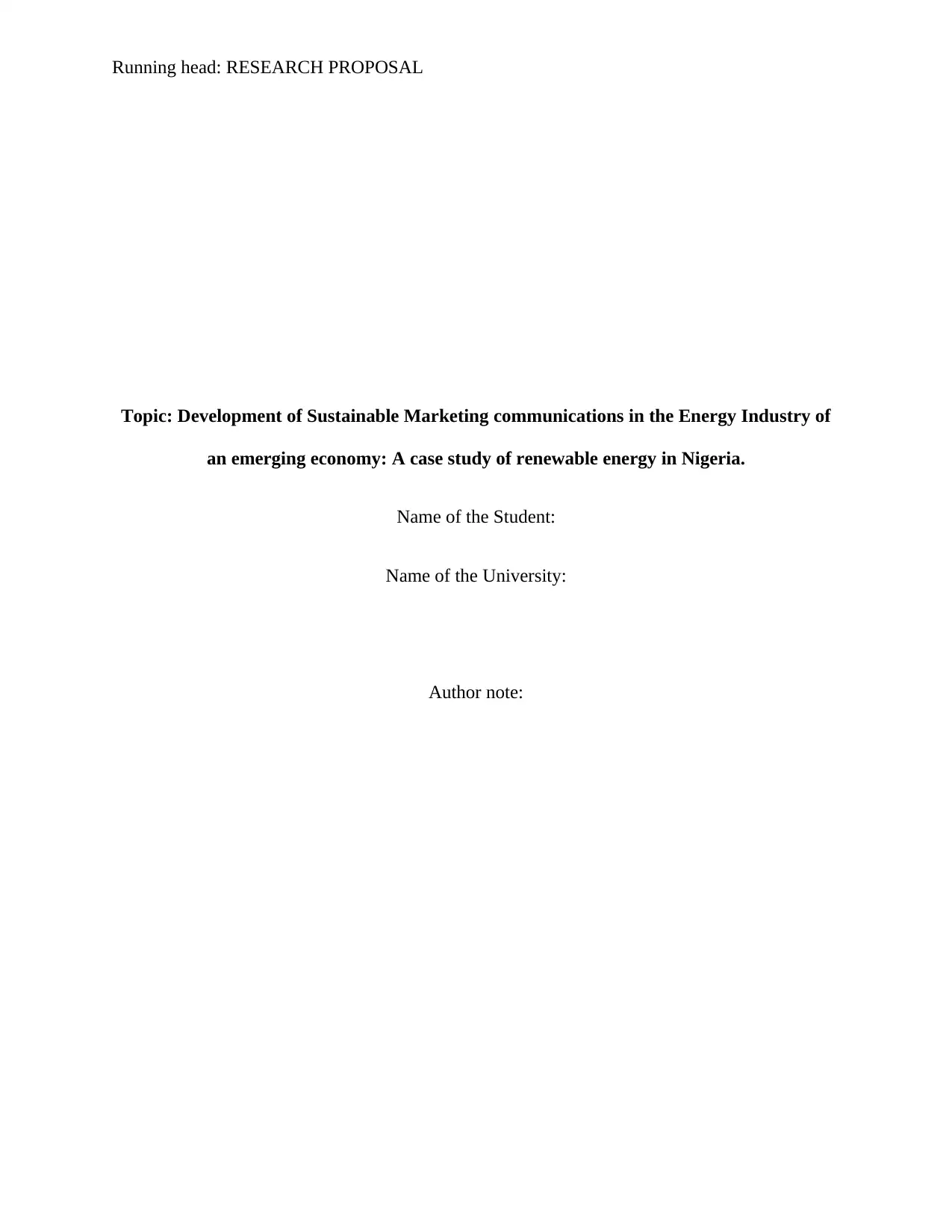
Running head: RESEARCH PROPOSAL
Topic: Development of Sustainable Marketing communications in the Energy Industry of
an emerging economy: A case study of renewable energy in Nigeria.
Name of the Student:
Name of the University:
Author note:
Topic: Development of Sustainable Marketing communications in the Energy Industry of
an emerging economy: A case study of renewable energy in Nigeria.
Name of the Student:
Name of the University:
Author note:
Paraphrase This Document
Need a fresh take? Get an instant paraphrase of this document with our AI Paraphraser
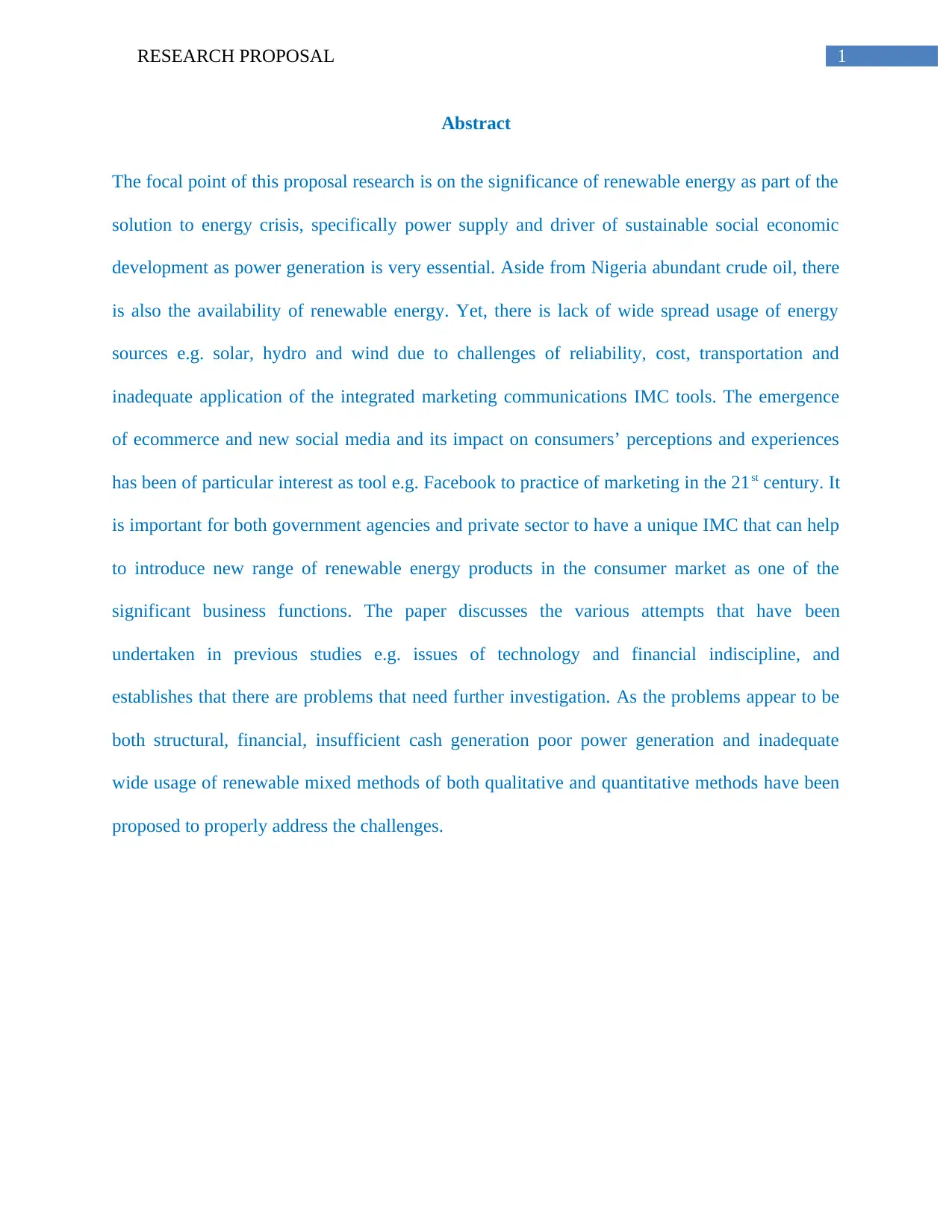
1RESEARCH PROPOSAL
Abstract
The focal point of this proposal research is on the significance of renewable energy as part of the
solution to energy crisis, specifically power supply and driver of sustainable social economic
development as power generation is very essential. Aside from Nigeria abundant crude oil, there
is also the availability of renewable energy. Yet, there is lack of wide spread usage of energy
sources e.g. solar, hydro and wind due to challenges of reliability, cost, transportation and
inadequate application of the integrated marketing communications IMC tools. The emergence
of ecommerce and new social media and its impact on consumers’ perceptions and experiences
has been of particular interest as tool e.g. Facebook to practice of marketing in the 21st century. It
is important for both government agencies and private sector to have a unique IMC that can help
to introduce new range of renewable energy products in the consumer market as one of the
significant business functions. The paper discusses the various attempts that have been
undertaken in previous studies e.g. issues of technology and financial indiscipline, and
establishes that there are problems that need further investigation. As the problems appear to be
both structural, financial, insufficient cash generation poor power generation and inadequate
wide usage of renewable mixed methods of both qualitative and quantitative methods have been
proposed to properly address the challenges.
Abstract
The focal point of this proposal research is on the significance of renewable energy as part of the
solution to energy crisis, specifically power supply and driver of sustainable social economic
development as power generation is very essential. Aside from Nigeria abundant crude oil, there
is also the availability of renewable energy. Yet, there is lack of wide spread usage of energy
sources e.g. solar, hydro and wind due to challenges of reliability, cost, transportation and
inadequate application of the integrated marketing communications IMC tools. The emergence
of ecommerce and new social media and its impact on consumers’ perceptions and experiences
has been of particular interest as tool e.g. Facebook to practice of marketing in the 21st century. It
is important for both government agencies and private sector to have a unique IMC that can help
to introduce new range of renewable energy products in the consumer market as one of the
significant business functions. The paper discusses the various attempts that have been
undertaken in previous studies e.g. issues of technology and financial indiscipline, and
establishes that there are problems that need further investigation. As the problems appear to be
both structural, financial, insufficient cash generation poor power generation and inadequate
wide usage of renewable mixed methods of both qualitative and quantitative methods have been
proposed to properly address the challenges.
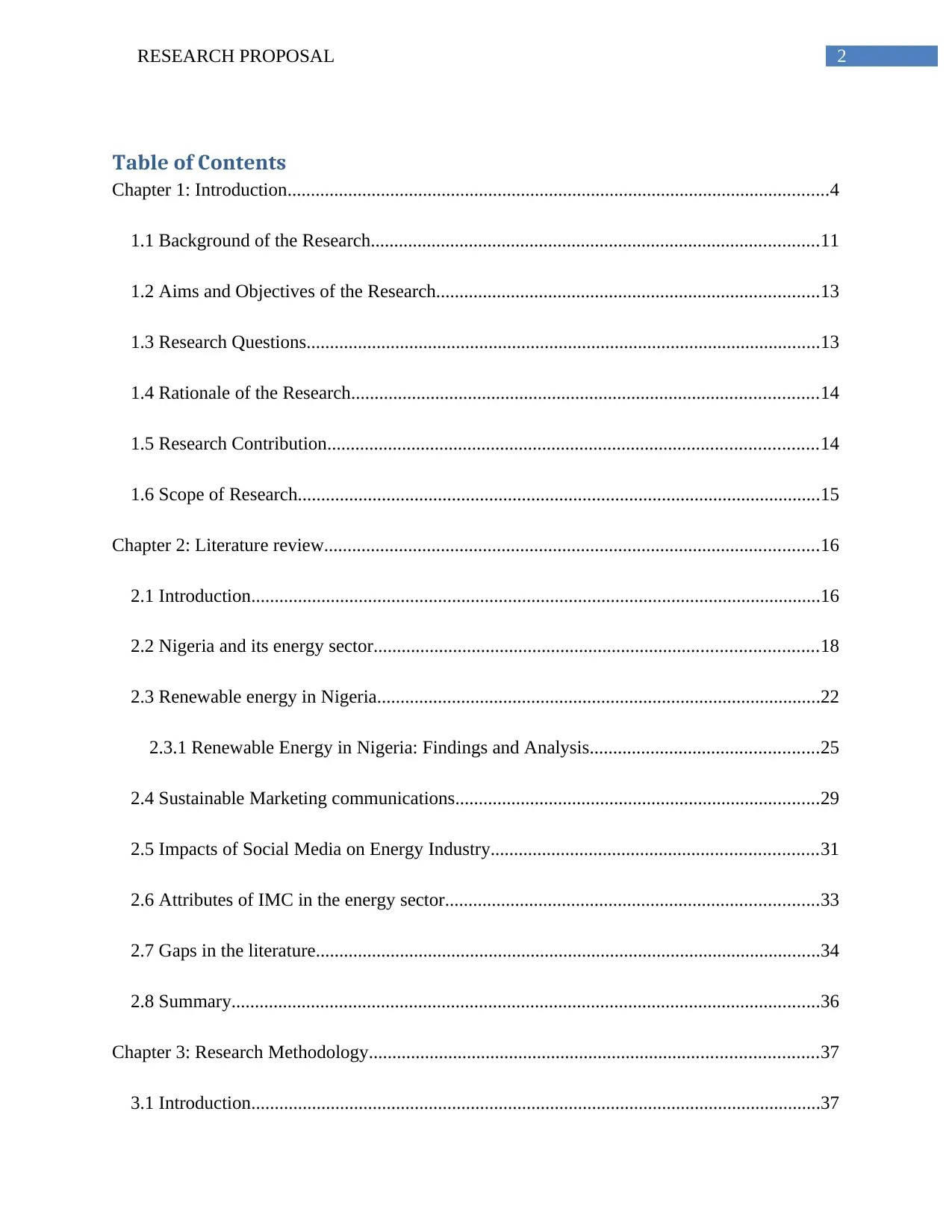
2RESEARCH PROPOSAL
Table of Contents
Chapter 1: Introduction....................................................................................................................4
1.1 Background of the Research................................................................................................11
1.2 Aims and Objectives of the Research..................................................................................13
1.3 Research Questions..............................................................................................................13
1.4 Rationale of the Research....................................................................................................14
1.5 Research Contribution.........................................................................................................14
1.6 Scope of Research................................................................................................................15
Chapter 2: Literature review..........................................................................................................16
2.1 Introduction..........................................................................................................................16
2.2 Nigeria and its energy sector...............................................................................................18
2.3 Renewable energy in Nigeria...............................................................................................22
2.3.1 Renewable Energy in Nigeria: Findings and Analysis.................................................25
2.4 Sustainable Marketing communications..............................................................................29
2.5 Impacts of Social Media on Energy Industry......................................................................31
2.6 Attributes of IMC in the energy sector................................................................................33
2.7 Gaps in the literature............................................................................................................34
2.8 Summary..............................................................................................................................36
Chapter 3: Research Methodology................................................................................................37
3.1 Introduction..........................................................................................................................37
Table of Contents
Chapter 1: Introduction....................................................................................................................4
1.1 Background of the Research................................................................................................11
1.2 Aims and Objectives of the Research..................................................................................13
1.3 Research Questions..............................................................................................................13
1.4 Rationale of the Research....................................................................................................14
1.5 Research Contribution.........................................................................................................14
1.6 Scope of Research................................................................................................................15
Chapter 2: Literature review..........................................................................................................16
2.1 Introduction..........................................................................................................................16
2.2 Nigeria and its energy sector...............................................................................................18
2.3 Renewable energy in Nigeria...............................................................................................22
2.3.1 Renewable Energy in Nigeria: Findings and Analysis.................................................25
2.4 Sustainable Marketing communications..............................................................................29
2.5 Impacts of Social Media on Energy Industry......................................................................31
2.6 Attributes of IMC in the energy sector................................................................................33
2.7 Gaps in the literature............................................................................................................34
2.8 Summary..............................................................................................................................36
Chapter 3: Research Methodology................................................................................................37
3.1 Introduction..........................................................................................................................37
⊘ This is a preview!⊘
Do you want full access?
Subscribe today to unlock all pages.

Trusted by 1+ million students worldwide
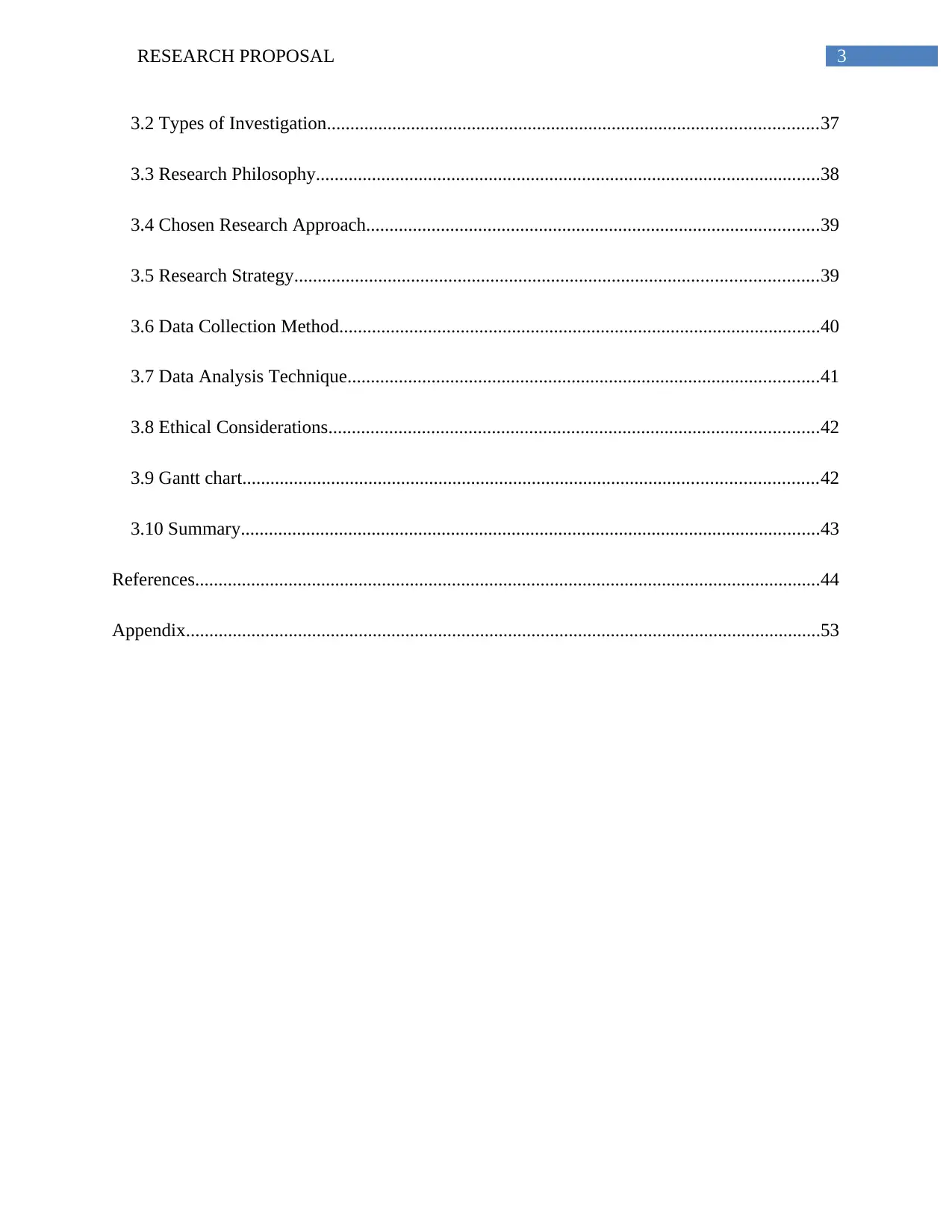
3RESEARCH PROPOSAL
3.2 Types of Investigation.........................................................................................................37
3.3 Research Philosophy............................................................................................................38
3.4 Chosen Research Approach.................................................................................................39
3.5 Research Strategy................................................................................................................39
3.6 Data Collection Method.......................................................................................................40
3.7 Data Analysis Technique.....................................................................................................41
3.8 Ethical Considerations.........................................................................................................42
3.9 Gantt chart...........................................................................................................................42
3.10 Summary............................................................................................................................43
References......................................................................................................................................44
Appendix........................................................................................................................................53
3.2 Types of Investigation.........................................................................................................37
3.3 Research Philosophy............................................................................................................38
3.4 Chosen Research Approach.................................................................................................39
3.5 Research Strategy................................................................................................................39
3.6 Data Collection Method.......................................................................................................40
3.7 Data Analysis Technique.....................................................................................................41
3.8 Ethical Considerations.........................................................................................................42
3.9 Gantt chart...........................................................................................................................42
3.10 Summary............................................................................................................................43
References......................................................................................................................................44
Appendix........................................................................................................................................53
Paraphrase This Document
Need a fresh take? Get an instant paraphrase of this document with our AI Paraphraser
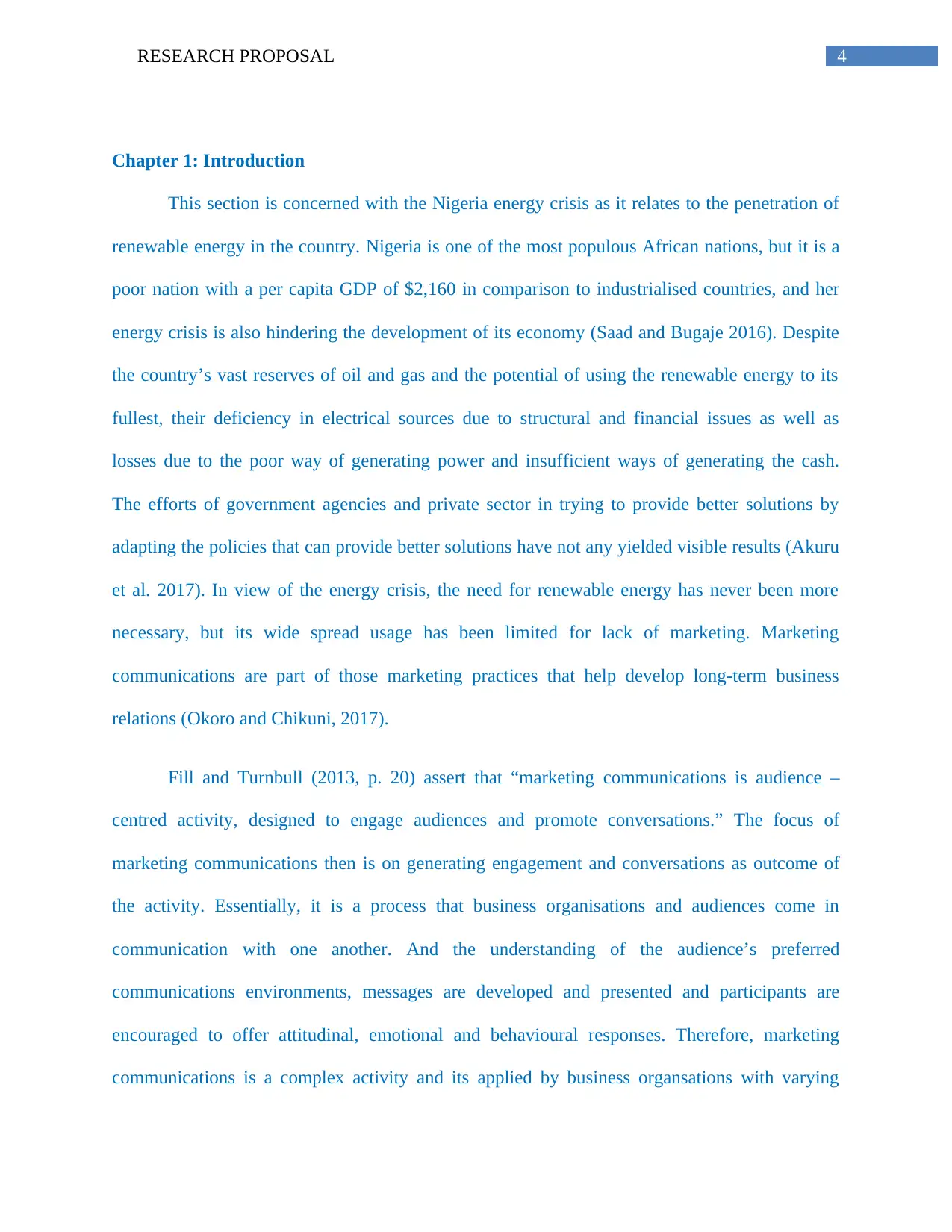
4RESEARCH PROPOSAL
Chapter 1: Introduction
This section is concerned with the Nigeria energy crisis as it relates to the penetration of
renewable energy in the country. Nigeria is one of the most populous African nations, but it is a
poor nation with a per capita GDP of $2,160 in comparison to industrialised countries, and her
energy crisis is also hindering the development of its economy (Saad and Bugaje 2016). Despite
the country’s vast reserves of oil and gas and the potential of using the renewable energy to its
fullest, their deficiency in electrical sources due to structural and financial issues as well as
losses due to the poor way of generating power and insufficient ways of generating the cash.
The efforts of government agencies and private sector in trying to provide better solutions by
adapting the policies that can provide better solutions have not any yielded visible results (Akuru
et al. 2017). In view of the energy crisis, the need for renewable energy has never been more
necessary, but its wide spread usage has been limited for lack of marketing. Marketing
communications are part of those marketing practices that help develop long-term business
relations (Okoro and Chikuni, 2017).
Fill and Turnbull (2013, p. 20) assert that “marketing communications is audience –
centred activity, designed to engage audiences and promote conversations.” The focus of
marketing communications then is on generating engagement and conversations as outcome of
the activity. Essentially, it is a process that business organisations and audiences come in
communication with one another. And the understanding of the audience’s preferred
communications environments, messages are developed and presented and participants are
encouraged to offer attitudinal, emotional and behavioural responses. Therefore, marketing
communications is a complex activity and its applied by business organsations with varying
Chapter 1: Introduction
This section is concerned with the Nigeria energy crisis as it relates to the penetration of
renewable energy in the country. Nigeria is one of the most populous African nations, but it is a
poor nation with a per capita GDP of $2,160 in comparison to industrialised countries, and her
energy crisis is also hindering the development of its economy (Saad and Bugaje 2016). Despite
the country’s vast reserves of oil and gas and the potential of using the renewable energy to its
fullest, their deficiency in electrical sources due to structural and financial issues as well as
losses due to the poor way of generating power and insufficient ways of generating the cash.
The efforts of government agencies and private sector in trying to provide better solutions by
adapting the policies that can provide better solutions have not any yielded visible results (Akuru
et al. 2017). In view of the energy crisis, the need for renewable energy has never been more
necessary, but its wide spread usage has been limited for lack of marketing. Marketing
communications are part of those marketing practices that help develop long-term business
relations (Okoro and Chikuni, 2017).
Fill and Turnbull (2013, p. 20) assert that “marketing communications is audience –
centred activity, designed to engage audiences and promote conversations.” The focus of
marketing communications then is on generating engagement and conversations as outcome of
the activity. Essentially, it is a process that business organisations and audiences come in
communication with one another. And the understanding of the audience’s preferred
communications environments, messages are developed and presented and participants are
encouraged to offer attitudinal, emotional and behavioural responses. Therefore, marketing
communications is a complex activity and its applied by business organsations with varying
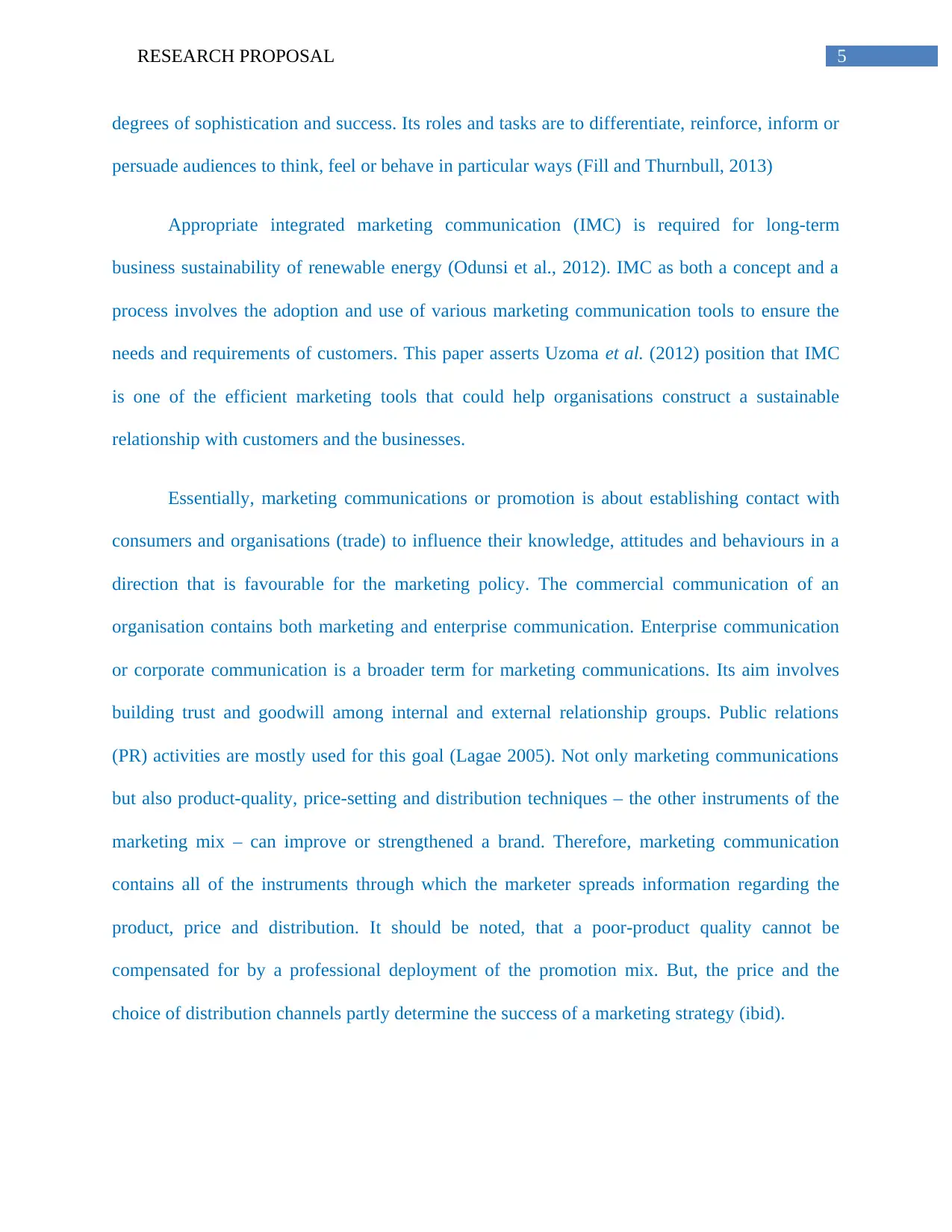
5RESEARCH PROPOSAL
degrees of sophistication and success. Its roles and tasks are to differentiate, reinforce, inform or
persuade audiences to think, feel or behave in particular ways (Fill and Thurnbull, 2013)
Appropriate integrated marketing communication (IMC) is required for long-term
business sustainability of renewable energy (Odunsi et al., 2012). IMC as both a concept and a
process involves the adoption and use of various marketing communication tools to ensure the
needs and requirements of customers. This paper asserts Uzoma et al. (2012) position that IMC
is one of the efficient marketing tools that could help organisations construct a sustainable
relationship with customers and the businesses.
Essentially, marketing communications or promotion is about establishing contact with
consumers and organisations (trade) to influence their knowledge, attitudes and behaviours in a
direction that is favourable for the marketing policy. The commercial communication of an
organisation contains both marketing and enterprise communication. Enterprise communication
or corporate communication is a broader term for marketing communications. Its aim involves
building trust and goodwill among internal and external relationship groups. Public relations
(PR) activities are mostly used for this goal (Lagae 2005). Not only marketing communications
but also product-quality, price-setting and distribution techniques – the other instruments of the
marketing mix – can improve or strengthened a brand. Therefore, marketing communication
contains all of the instruments through which the marketer spreads information regarding the
product, price and distribution. It should be noted, that a poor-product quality cannot be
compensated for by a professional deployment of the promotion mix. But, the price and the
choice of distribution channels partly determine the success of a marketing strategy (ibid).
degrees of sophistication and success. Its roles and tasks are to differentiate, reinforce, inform or
persuade audiences to think, feel or behave in particular ways (Fill and Thurnbull, 2013)
Appropriate integrated marketing communication (IMC) is required for long-term
business sustainability of renewable energy (Odunsi et al., 2012). IMC as both a concept and a
process involves the adoption and use of various marketing communication tools to ensure the
needs and requirements of customers. This paper asserts Uzoma et al. (2012) position that IMC
is one of the efficient marketing tools that could help organisations construct a sustainable
relationship with customers and the businesses.
Essentially, marketing communications or promotion is about establishing contact with
consumers and organisations (trade) to influence their knowledge, attitudes and behaviours in a
direction that is favourable for the marketing policy. The commercial communication of an
organisation contains both marketing and enterprise communication. Enterprise communication
or corporate communication is a broader term for marketing communications. Its aim involves
building trust and goodwill among internal and external relationship groups. Public relations
(PR) activities are mostly used for this goal (Lagae 2005). Not only marketing communications
but also product-quality, price-setting and distribution techniques – the other instruments of the
marketing mix – can improve or strengthened a brand. Therefore, marketing communication
contains all of the instruments through which the marketer spreads information regarding the
product, price and distribution. It should be noted, that a poor-product quality cannot be
compensated for by a professional deployment of the promotion mix. But, the price and the
choice of distribution channels partly determine the success of a marketing strategy (ibid).
⊘ This is a preview!⊘
Do you want full access?
Subscribe today to unlock all pages.

Trusted by 1+ million students worldwide
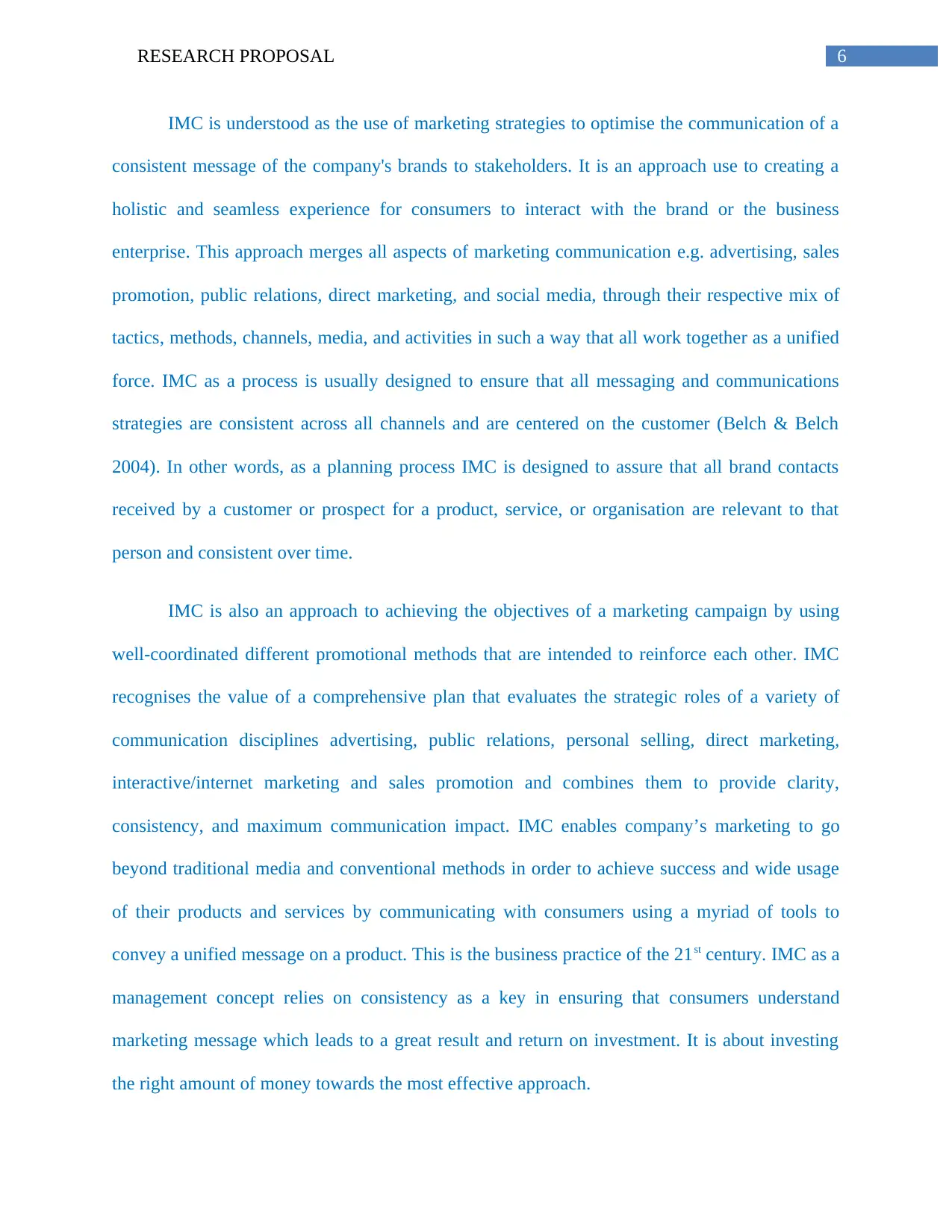
6RESEARCH PROPOSAL
IMC is understood as the use of marketing strategies to optimise the communication of a
consistent message of the company's brands to stakeholders. It is an approach use to creating a
holistic and seamless experience for consumers to interact with the brand or the business
enterprise. This approach merges all aspects of marketing communication e.g. advertising, sales
promotion, public relations, direct marketing, and social media, through their respective mix of
tactics, methods, channels, media, and activities in such a way that all work together as a unified
force. IMC as a process is usually designed to ensure that all messaging and communications
strategies are consistent across all channels and are centered on the customer (Belch & Belch
2004). In other words, as a planning process IMC is designed to assure that all brand contacts
received by a customer or prospect for a product, service, or organisation are relevant to that
person and consistent over time.
IMC is also an approach to achieving the objectives of a marketing campaign by using
well-coordinated different promotional methods that are intended to reinforce each other. IMC
recognises the value of a comprehensive plan that evaluates the strategic roles of a variety of
communication disciplines advertising, public relations, personal selling, direct marketing,
interactive/internet marketing and sales promotion and combines them to provide clarity,
consistency, and maximum communication impact. IMC enables company’s marketing to go
beyond traditional media and conventional methods in order to achieve success and wide usage
of their products and services by communicating with consumers using a myriad of tools to
convey a unified message on a product. This is the business practice of the 21st century. IMC as a
management concept relies on consistency as a key in ensuring that consumers understand
marketing message which leads to a great result and return on investment. It is about investing
the right amount of money towards the most effective approach.
IMC is understood as the use of marketing strategies to optimise the communication of a
consistent message of the company's brands to stakeholders. It is an approach use to creating a
holistic and seamless experience for consumers to interact with the brand or the business
enterprise. This approach merges all aspects of marketing communication e.g. advertising, sales
promotion, public relations, direct marketing, and social media, through their respective mix of
tactics, methods, channels, media, and activities in such a way that all work together as a unified
force. IMC as a process is usually designed to ensure that all messaging and communications
strategies are consistent across all channels and are centered on the customer (Belch & Belch
2004). In other words, as a planning process IMC is designed to assure that all brand contacts
received by a customer or prospect for a product, service, or organisation are relevant to that
person and consistent over time.
IMC is also an approach to achieving the objectives of a marketing campaign by using
well-coordinated different promotional methods that are intended to reinforce each other. IMC
recognises the value of a comprehensive plan that evaluates the strategic roles of a variety of
communication disciplines advertising, public relations, personal selling, direct marketing,
interactive/internet marketing and sales promotion and combines them to provide clarity,
consistency, and maximum communication impact. IMC enables company’s marketing to go
beyond traditional media and conventional methods in order to achieve success and wide usage
of their products and services by communicating with consumers using a myriad of tools to
convey a unified message on a product. This is the business practice of the 21st century. IMC as a
management concept relies on consistency as a key in ensuring that consumers understand
marketing message which leads to a great result and return on investment. It is about investing
the right amount of money towards the most effective approach.
Paraphrase This Document
Need a fresh take? Get an instant paraphrase of this document with our AI Paraphraser
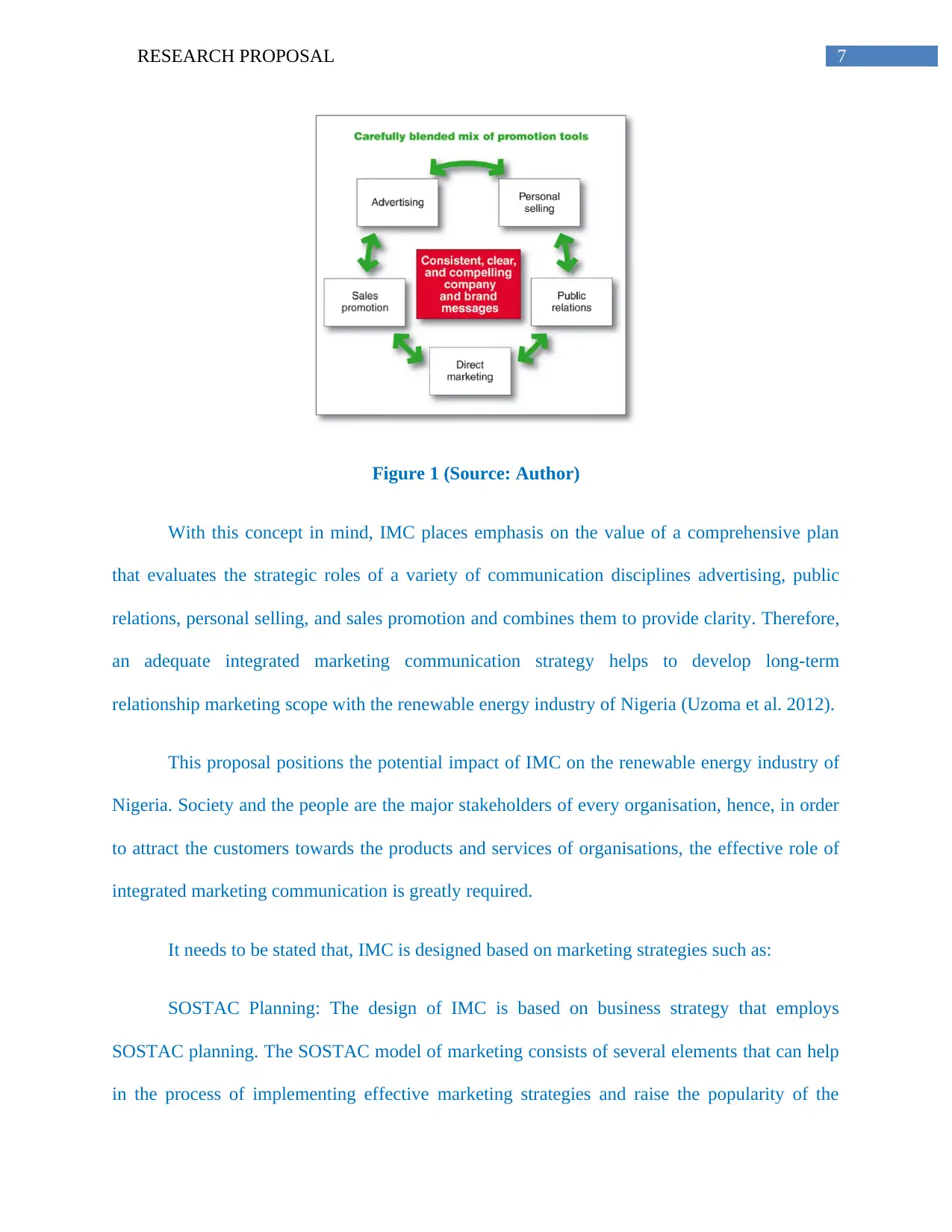
7RESEARCH PROPOSAL
Figure 1 (Source: Author)
With this concept in mind, IMC places emphasis on the value of a comprehensive plan
that evaluates the strategic roles of a variety of communication disciplines advertising, public
relations, personal selling, and sales promotion and combines them to provide clarity. Therefore,
an adequate integrated marketing communication strategy helps to develop long-term
relationship marketing scope with the renewable energy industry of Nigeria (Uzoma et al. 2012).
This proposal positions the potential impact of IMC on the renewable energy industry of
Nigeria. Society and the people are the major stakeholders of every organisation, hence, in order
to attract the customers towards the products and services of organisations, the effective role of
integrated marketing communication is greatly required.
It needs to be stated that, IMC is designed based on marketing strategies such as:
SOSTAC Planning: The design of IMC is based on business strategy that employs
SOSTAC planning. The SOSTAC model of marketing consists of several elements that can help
in the process of implementing effective marketing strategies and raise the popularity of the
Figure 1 (Source: Author)
With this concept in mind, IMC places emphasis on the value of a comprehensive plan
that evaluates the strategic roles of a variety of communication disciplines advertising, public
relations, personal selling, and sales promotion and combines them to provide clarity. Therefore,
an adequate integrated marketing communication strategy helps to develop long-term
relationship marketing scope with the renewable energy industry of Nigeria (Uzoma et al. 2012).
This proposal positions the potential impact of IMC on the renewable energy industry of
Nigeria. Society and the people are the major stakeholders of every organisation, hence, in order
to attract the customers towards the products and services of organisations, the effective role of
integrated marketing communication is greatly required.
It needs to be stated that, IMC is designed based on marketing strategies such as:
SOSTAC Planning: The design of IMC is based on business strategy that employs
SOSTAC planning. The SOSTAC model of marketing consists of several elements that can help
in the process of implementing effective marketing strategies and raise the popularity of the
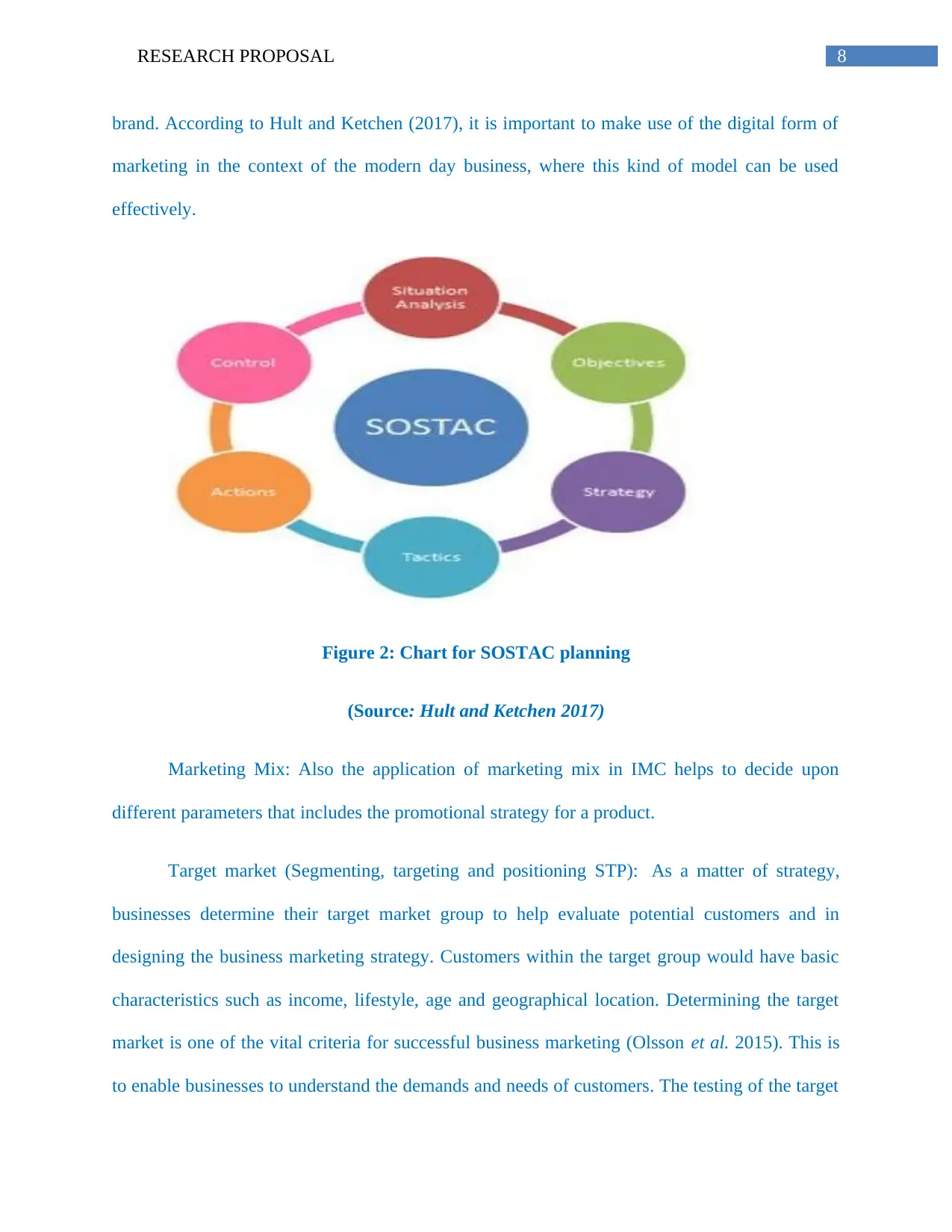
8RESEARCH PROPOSAL
brand. According to Hult and Ketchen (2017), it is important to make use of the digital form of
marketing in the context of the modern day business, where this kind of model can be used
effectively.
Figure 2: Chart for SOSTAC planning
(Source: Hult and Ketchen 2017)
Marketing Mix: Also the application of marketing mix in IMC helps to decide upon
different parameters that includes the promotional strategy for a product.
Target market (Segmenting, targeting and positioning STP): As a matter of strategy,
businesses determine their target market group to help evaluate potential customers and in
designing the business marketing strategy. Customers within the target group would have basic
characteristics such as income, lifestyle, age and geographical location. Determining the target
market is one of the vital criteria for successful business marketing (Olsson et al. 2015). This is
to enable businesses to understand the demands and needs of customers. The testing of the target
brand. According to Hult and Ketchen (2017), it is important to make use of the digital form of
marketing in the context of the modern day business, where this kind of model can be used
effectively.
Figure 2: Chart for SOSTAC planning
(Source: Hult and Ketchen 2017)
Marketing Mix: Also the application of marketing mix in IMC helps to decide upon
different parameters that includes the promotional strategy for a product.
Target market (Segmenting, targeting and positioning STP): As a matter of strategy,
businesses determine their target market group to help evaluate potential customers and in
designing the business marketing strategy. Customers within the target group would have basic
characteristics such as income, lifestyle, age and geographical location. Determining the target
market is one of the vital criteria for successful business marketing (Olsson et al. 2015). This is
to enable businesses to understand the demands and needs of customers. The testing of the target
⊘ This is a preview!⊘
Do you want full access?
Subscribe today to unlock all pages.

Trusted by 1+ million students worldwide
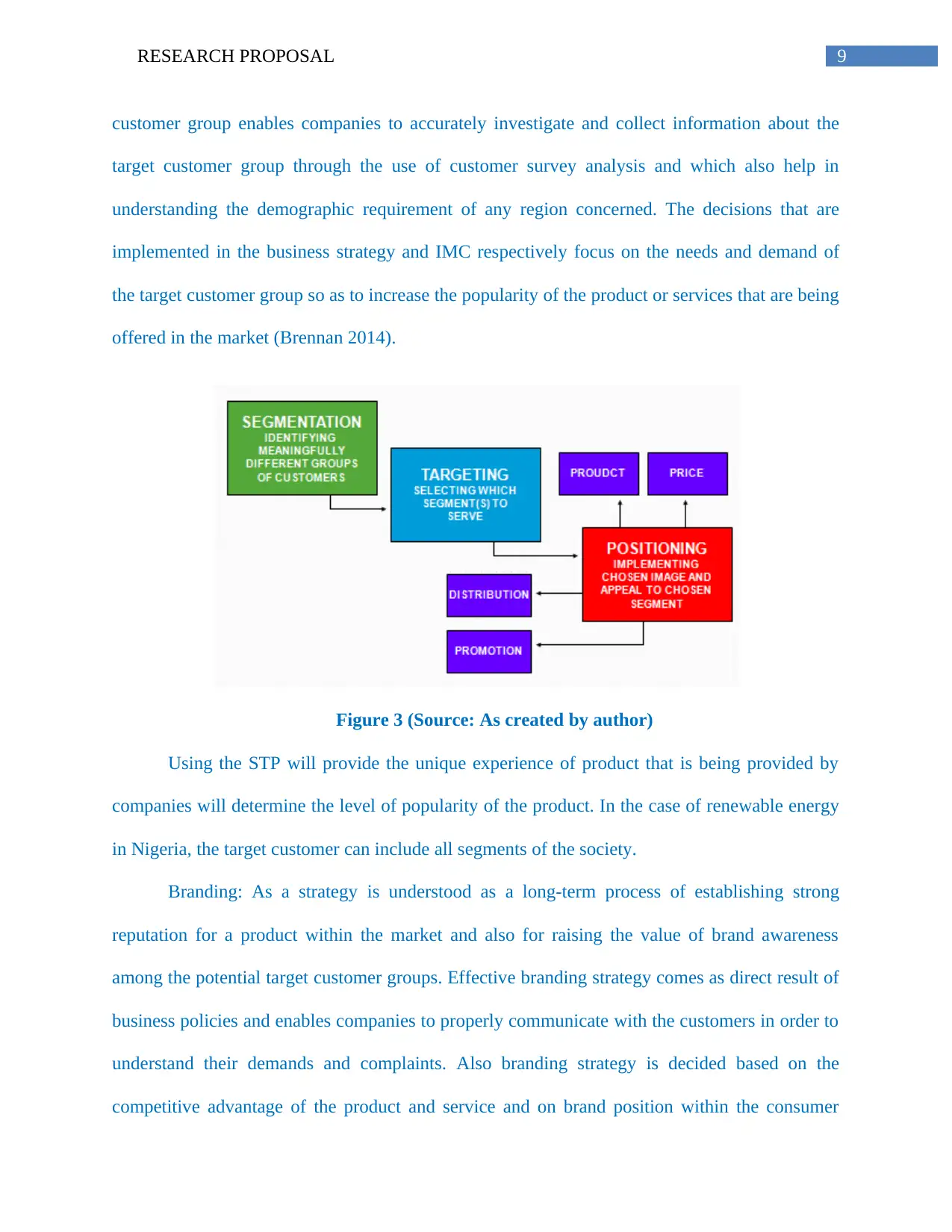
9RESEARCH PROPOSAL
customer group enables companies to accurately investigate and collect information about the
target customer group through the use of customer survey analysis and which also help in
understanding the demographic requirement of any region concerned. The decisions that are
implemented in the business strategy and IMC respectively focus on the needs and demand of
the target customer group so as to increase the popularity of the product or services that are being
offered in the market (Brennan 2014).
Figure 3 (Source: As created by author)
Using the STP will provide the unique experience of product that is being provided by
companies will determine the level of popularity of the product. In the case of renewable energy
in Nigeria, the target customer can include all segments of the society.
Branding: As a strategy is understood as a long-term process of establishing strong
reputation for a product within the market and also for raising the value of brand awareness
among the potential target customer groups. Effective branding strategy comes as direct result of
business policies and enables companies to properly communicate with the customers in order to
understand their demands and complaints. Also branding strategy is decided based on the
competitive advantage of the product and service and on brand position within the consumer
customer group enables companies to accurately investigate and collect information about the
target customer group through the use of customer survey analysis and which also help in
understanding the demographic requirement of any region concerned. The decisions that are
implemented in the business strategy and IMC respectively focus on the needs and demand of
the target customer group so as to increase the popularity of the product or services that are being
offered in the market (Brennan 2014).
Figure 3 (Source: As created by author)
Using the STP will provide the unique experience of product that is being provided by
companies will determine the level of popularity of the product. In the case of renewable energy
in Nigeria, the target customer can include all segments of the society.
Branding: As a strategy is understood as a long-term process of establishing strong
reputation for a product within the market and also for raising the value of brand awareness
among the potential target customer groups. Effective branding strategy comes as direct result of
business policies and enables companies to properly communicate with the customers in order to
understand their demands and complaints. Also branding strategy is decided based on the
competitive advantage of the product and service and on brand position within the consumer
Paraphrase This Document
Need a fresh take? Get an instant paraphrase of this document with our AI Paraphraser
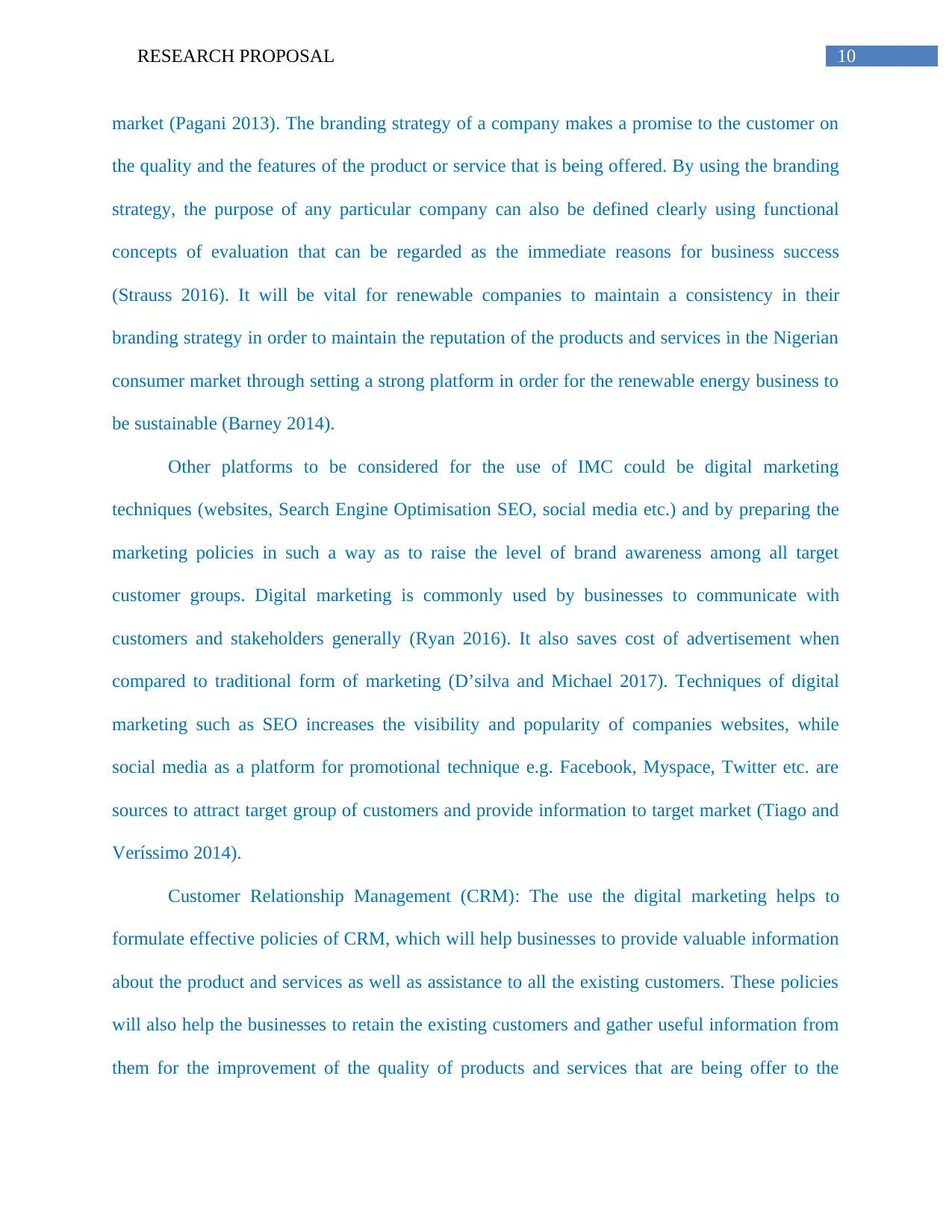
10RESEARCH PROPOSAL
market (Pagani 2013). The branding strategy of a company makes a promise to the customer on
the quality and the features of the product or service that is being offered. By using the branding
strategy, the purpose of any particular company can also be defined clearly using functional
concepts of evaluation that can be regarded as the immediate reasons for business success
(Strauss 2016). It will be vital for renewable companies to maintain a consistency in their
branding strategy in order to maintain the reputation of the products and services in the Nigerian
consumer market through setting a strong platform in order for the renewable energy business to
be sustainable (Barney 2014).
Other platforms to be considered for the use of IMC could be digital marketing
techniques (websites, Search Engine Optimisation SEO, social media etc.) and by preparing the
marketing policies in such a way as to raise the level of brand awareness among all target
customer groups. Digital marketing is commonly used by businesses to communicate with
customers and stakeholders generally (Ryan 2016). It also saves cost of advertisement when
compared to traditional form of marketing (D’silva and Michael 2017). Techniques of digital
marketing such as SEO increases the visibility and popularity of companies websites, while
social media as a platform for promotional technique e.g. Facebook, Myspace, Twitter etc. are
sources to attract target group of customers and provide information to target market (Tiago and
Veríssimo 2014).
Customer Relationship Management (CRM): The use the digital marketing helps to
formulate effective policies of CRM, which will help businesses to provide valuable information
about the product and services as well as assistance to all the existing customers. These policies
will also help the businesses to retain the existing customers and gather useful information from
them for the improvement of the quality of products and services that are being offer to the
market (Pagani 2013). The branding strategy of a company makes a promise to the customer on
the quality and the features of the product or service that is being offered. By using the branding
strategy, the purpose of any particular company can also be defined clearly using functional
concepts of evaluation that can be regarded as the immediate reasons for business success
(Strauss 2016). It will be vital for renewable companies to maintain a consistency in their
branding strategy in order to maintain the reputation of the products and services in the Nigerian
consumer market through setting a strong platform in order for the renewable energy business to
be sustainable (Barney 2014).
Other platforms to be considered for the use of IMC could be digital marketing
techniques (websites, Search Engine Optimisation SEO, social media etc.) and by preparing the
marketing policies in such a way as to raise the level of brand awareness among all target
customer groups. Digital marketing is commonly used by businesses to communicate with
customers and stakeholders generally (Ryan 2016). It also saves cost of advertisement when
compared to traditional form of marketing (D’silva and Michael 2017). Techniques of digital
marketing such as SEO increases the visibility and popularity of companies websites, while
social media as a platform for promotional technique e.g. Facebook, Myspace, Twitter etc. are
sources to attract target group of customers and provide information to target market (Tiago and
Veríssimo 2014).
Customer Relationship Management (CRM): The use the digital marketing helps to
formulate effective policies of CRM, which will help businesses to provide valuable information
about the product and services as well as assistance to all the existing customers. These policies
will also help the businesses to retain the existing customers and gather useful information from
them for the improvement of the quality of products and services that are being offer to the
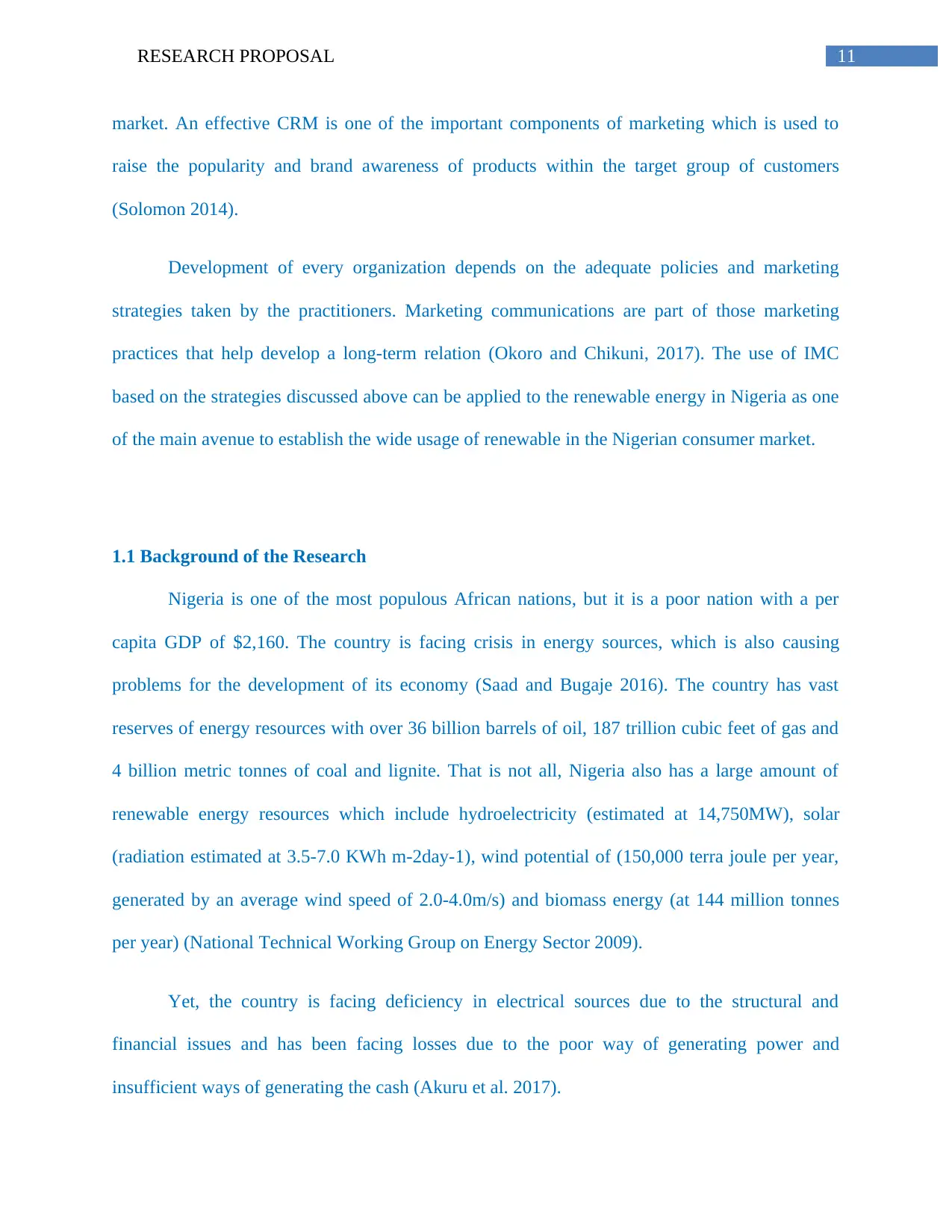
11RESEARCH PROPOSAL
market. An effective CRM is one of the important components of marketing which is used to
raise the popularity and brand awareness of products within the target group of customers
(Solomon 2014).
Development of every organization depends on the adequate policies and marketing
strategies taken by the practitioners. Marketing communications are part of those marketing
practices that help develop a long-term relation (Okoro and Chikuni, 2017). The use of IMC
based on the strategies discussed above can be applied to the renewable energy in Nigeria as one
of the main avenue to establish the wide usage of renewable in the Nigerian consumer market.
1.1 Background of the Research
Nigeria is one of the most populous African nations, but it is a poor nation with a per
capita GDP of $2,160. The country is facing crisis in energy sources, which is also causing
problems for the development of its economy (Saad and Bugaje 2016). The country has vast
reserves of energy resources with over 36 billion barrels of oil, 187 trillion cubic feet of gas and
4 billion metric tonnes of coal and lignite. That is not all, Nigeria also has a large amount of
renewable energy resources which include hydroelectricity (estimated at 14,750MW), solar
(radiation estimated at 3.5-7.0 KWh m-2day-1), wind potential of (150,000 terra joule per year,
generated by an average wind speed of 2.0-4.0m/s) and biomass energy (at 144 million tonnes
per year) (National Technical Working Group on Energy Sector 2009).
Yet, the country is facing deficiency in electrical sources due to the structural and
financial issues and has been facing losses due to the poor way of generating power and
insufficient ways of generating the cash (Akuru et al. 2017).
market. An effective CRM is one of the important components of marketing which is used to
raise the popularity and brand awareness of products within the target group of customers
(Solomon 2014).
Development of every organization depends on the adequate policies and marketing
strategies taken by the practitioners. Marketing communications are part of those marketing
practices that help develop a long-term relation (Okoro and Chikuni, 2017). The use of IMC
based on the strategies discussed above can be applied to the renewable energy in Nigeria as one
of the main avenue to establish the wide usage of renewable in the Nigerian consumer market.
1.1 Background of the Research
Nigeria is one of the most populous African nations, but it is a poor nation with a per
capita GDP of $2,160. The country is facing crisis in energy sources, which is also causing
problems for the development of its economy (Saad and Bugaje 2016). The country has vast
reserves of energy resources with over 36 billion barrels of oil, 187 trillion cubic feet of gas and
4 billion metric tonnes of coal and lignite. That is not all, Nigeria also has a large amount of
renewable energy resources which include hydroelectricity (estimated at 14,750MW), solar
(radiation estimated at 3.5-7.0 KWh m-2day-1), wind potential of (150,000 terra joule per year,
generated by an average wind speed of 2.0-4.0m/s) and biomass energy (at 144 million tonnes
per year) (National Technical Working Group on Energy Sector 2009).
Yet, the country is facing deficiency in electrical sources due to the structural and
financial issues and has been facing losses due to the poor way of generating power and
insufficient ways of generating the cash (Akuru et al. 2017).
⊘ This is a preview!⊘
Do you want full access?
Subscribe today to unlock all pages.

Trusted by 1+ million students worldwide
1 out of 60
Related Documents
Your All-in-One AI-Powered Toolkit for Academic Success.
+13062052269
info@desklib.com
Available 24*7 on WhatsApp / Email
![[object Object]](/_next/static/media/star-bottom.7253800d.svg)
Unlock your academic potential
Copyright © 2020–2025 A2Z Services. All Rights Reserved. Developed and managed by ZUCOL.




